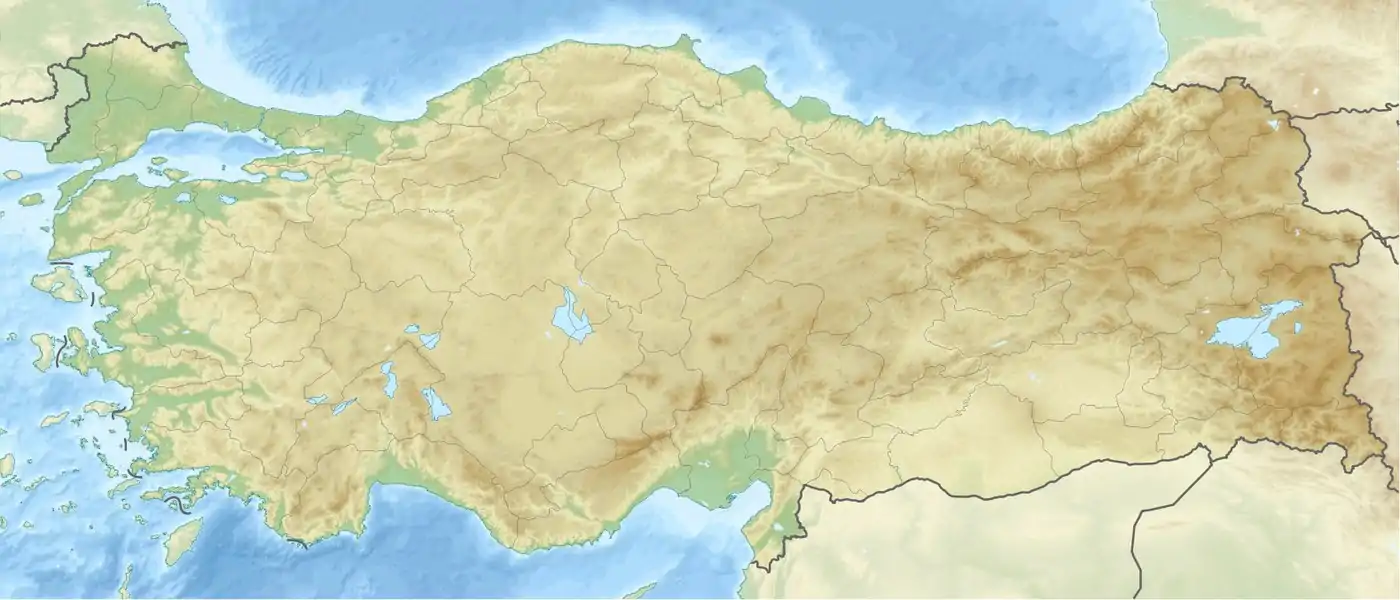Bakırçay
Bakırçay (Latin name: Caicus, also Caecus; Ancient Greek: Κάϊκος, transliterated as Kaïkos; formerly Astraeus (Ἀστραῖος) is the current name of a river of Asia Minor that rises in the Temnus mountains and flows through Lydia, Mysia, and Aeolis before it debouches into the Elaitic Gulf.[1][2] To the Hittites, it may have been the Seha river, however the modern Gediz river further south is a more likely candidate. The modern Turkish name of the river is Bakırçay (formerly the Aksu), and it is located in the Asian part of Turkey.
| Bakırçay | |
|---|---|
 | |
| Physical characteristics | |
| Mouth | |
• coordinates | 38.9327°N 26.9665°E |
The river is first mentioned by Hesiod,[3] who, along with the other poets, fixes the quantity of the penultimate syllable of Caicus. Plutarch relates that the name of the river was originally Astraeus but was changed after Caicus, a son of Hermes, threw himself into it after sleeping with his sister Alcippe.[4]
Strabo (p. 616) says that the sources of the Caicus are in a plain separated by the range of Temnus from the plain of Apiae, and that the plain of Apia lies above the plain of Thebe in the interior. He adds that there also flows from Tetanus a river (the Mysius) which joins the Caicus below its source. The Caicus enters the sea approximately 12 km from Pitane, and 3 km from Elaea. Elaea was the port of Pergamon, which was on the Caicus, approximately 25 km from Elaea.[5] At the source of the Caicus, according to Strabo, was a place called Gergitha.
The course of this river has undoubtedly changed since antiquity; nor is it easy to assign the proper ancient names to the branches in the ordinary maps. Leake infers from the direction of L. Scipio's march[6] from Troy to the Hyrcanian plain, that the north-eastern branch of the river of Pergamon (Bergama or Beryma) which flows by Menduria (possibly Gergitha) and Balıkesir (Caesaraea) is that which was anciently called Caicus; and he makes the Mysius join it on the right bank.[7] The Caicus as it seems is formed by two streams which meet between 50 and 65 km above its mouth, and it drains an extensive and fertile country.
See also
References
- Herodotus. The Histories. vi. 28; vii. 42.
- Hazlitt. Classical Gazetteer
- Hesiod. Theogony 343
- William Smith. Dictionary of Greek and Roman Biography and Mythology
- Strabo p. 615.
- Livy. xxxvii. 37
- William Martin Leake. Asia Minor, p. 269.
- Smith, William (editor); Dictionary of Greek and Roman Geography, "Stratoniceia", London, (1854)
![]() This article incorporates text from a publication now in the public domain: Smith, William, ed. (1854–1857). "Caicus". Dictionary of Greek and Roman Geography. London: John Murray.
This article incorporates text from a publication now in the public domain: Smith, William, ed. (1854–1857). "Caicus". Dictionary of Greek and Roman Geography. London: John Murray.
